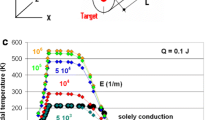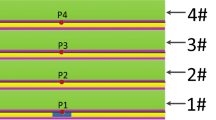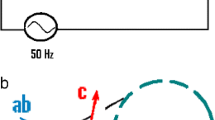Abstract
A multi-physics finite element model of high-temperature superconductors (HTS) will be presented in this article. The electrical-thermal model is mainly based on Maxwell’s equation and basic heat transfer equation to calculate the temperature propagation along the length of the superconducting tapes. According to the calculated temperature profile during quench, the surface thermal stress of the tape is obtained by a structural model. This model can be used to evaluate the degradation of tape performance due to the surface thermal stress, and the results can be used to minimize these effects in the SFCL system. The proposed model is used to investigate the uneven tape, the thickness of the copper layer and YBCO layer which is non-uniform. Methods of smoothing the degradation effect by adding auxiliary fixed points to the tape and changing the basic thickness of copper layer are discussed.
Similar content being viewed by others
Avoid common mistakes on your manuscript.
1 Introduction
With the development of high-temperature superconducting materials, more applications on electric utility devices will be used in the power system. In the same time, the power system has strict requirements to the superconducting strips [1] in order to make sure the applications will not affect the stability and safety, especially in the high voltage level. The superconducting materials must have a sufficiently high homogeneity so that these applications will work in a steady condition and will not be easily damaged [2]. However, due to the current technology, some of the technical indicators of the strip such as the critical current density and the thickness of the stability layer cannot be completely uniform. This may lead to some abnormal operating state or even system failure. Therefore, in the design of practical applications, the impact of these defects needs to be taken into consideration.
This article will focus on the YBCO strips used in resistive type superconducting fault current limiters (SFCL) [3, 4], which can be very sensitive to the uniformity of the strips. This article will discuss the non-uniformity of critical current density and thickness of the stability layer, which may lead to an increase of temperature and strain in the uneven parts. In the simulation, the maximum deviation of the stability layer is set to 20 μm, the maximum deviation of critical current is set to 20 %, and the elements of the simulating strip are all obtained from the YBCO strip produced by Shanghai Jiao Tong University.
According to previous research, the critical current of tape changes not only with temperature but also with strain. Once the strain exceeds the certain line which will be shown as symbol of ε irr, the degradation of the critical current will be irreversible. If this occurs in an SFCL, it will make the SFCL and further off-line repairing needed. In order to avoid this kind of situation, an electrical-thermal-structural FEM model will be introduced in this paper. Firstly, the strain in the uniform strip will be discussed; then several defects of tape, such as unevenness on copper layer and YBCO layer, will be considered; and then several measures, such as changing the basic thickness of copper layer and the distance of the fixed points, will be introduced to minimize the influence of the defect, which means to prevent the strain from crossing the irreversible line.
2 Geometry and Model
This model is a thermal-electrical-structural coupled finite element model. The physical structure and main internal connection of the model are shown in Fig. 1.
This model is built in x–z plane, which is the same as direction of the current. The model is built as single-sided copper structure and it mainly contains two parts: the YBCO layer and the copper layer. The equivalent resistivity of the YBCO layer varies with temperature, strain and current [5, 6]. The resistivity of copper layer varies only with temperature. In order to simplify the computing, the thickness of YBCO is expanded by a factor of 20 [7], and the material properties have been also adjusted correspondingly; other elements of the model are shown in Table 1.
The model uses only the basic formulations in the three physical fields, and takes joule heat and thermal stress as middle elements. The resistivity formulation of the YBCO layer and the relationship between critical current density and temperature are given by Eq. (1):
while the relationship between critical current and strain [8] is shown in Fig. 2.
After setting all the elements of different materials into the model, two working conditions are simulated in this paper: the first one contains the natural cooling process and the normal working state, and the other one contains only the quenching process
2.1 Natural Cooling Process and Normal Working State
As the temperature changes from the room temperature to the liquid nitrogen temperature, different layers will shrink by different factors. This is because the tape is fixed on a kind of composite material called G10 whose thermal expansion coefficient is only a quarter of copper. The tape will suffer from the thermal stress, which may cause the degradation of tape.
In this part of simulation, in order to obtain the initial stress of the YBCO tapes, the initial temperature of the tape is set to three different values (275, 295 and 315 K), while at the same time the length of the tape changes from 10 to 100 cm. From these three groups of simulations, the relationship between the tape length, the initial temperature and the maximum strain is obtained as is shown in Fig. 3.
As is shown in Fig. 3, when the strip gets into the liquid nitrogen, the initial strain may come to a nearly 0.35 % value. This value does not change with the strip length, but relies on the initial room temperature.
2.2 Quenching Process
After loading the calculated initial strain value into the superconducting model, a simple sine voltage wave will be set to the boundaries as a quenching voltage. With the heat generated by the quench, the temperature in the strip will raise sharply, as the strain inside it. The strain might be several times stronger than in the normal state. The purpose of this simulation is obtaining the strain distributions of tapes with different defects, so as to find out whether the tape will be destructively damaged under these situations. And these results may be used as the basis to design the SFCL.
Figure 4 shows the maximum strain on a uniform HTS tape during the quench.
As is shown in Fig. 4, during the quench, the temperature of the strip will grow back to the room temperature, or even much higher than that. So the initial stress can be reduced, and as a result the strain will decrease. However, when the voltage on the strip is more than 1.1 V/cm, which means the temperature goes much higher than the room temperature, the maximum strain will be more than the irreversible line [9, 10] and degradation will occur.
From this part, to a uniform tape, unless extreme quench happens, it is not easy to reach the unrecoverable line. However, the actual superconducting tapes cannot be as homogeneous as in the simulation. It is very likely that the tape has defective parts. The quenching process of defective tape will be introduced in the next section.
3 Results and Discussion
3.1 The Unevenness of the Copper Layer
Due to the limitation of the existing technology, the thickness of the copper layer would not achieve uniformity. The different thickness of the copper layer will cause partial change of both the stress and the temperature distribution [11]. This kind of non-uniform defect will impact the working condition of the entire strip. Figure 5 shows deformation during the quench when a defect of copper layer (−20 μm) occurs at different positions, while the voltage fall on the strip is 0.5 V per centimeter.
For example, the length of a strip is set as 30 cm, and the copper layer defect is added to several different positions as Fig. 5 shows. From the results of these simulations, the strain of the weak point, edge point and the rest of the points are all shown in Table 2. From the table we can find that the biggest strain probability occurs when the copper uneven point appears at the 40 % point off the edge. In order to consider the most serious condition, the rest simulations of this part are all based on a strip that will have an uneven point at the 40 % part off the edge.
As the voltage fall on the strip grows, the strain of weak point might go over the irreversible line. In order to reduce the impact of the defect, measures such as changing the length of the strip and increasing the basic thickness of the copper layer are simulated. The effect of these methods is shown in Figs. 6–7.
Figure 6 shows that the strain at the uneven point increases with the length of the strip, which means that, as the distance between the two fixed points decreases, the strip can achieve a greater irreversible voltage. Figure 7 shows that the strain at the uneven point also depends on the thickness of the copper layer: for a 30-cm long strip, according to the results of simulations, 150 μm might be the best thickness to reduce the influence of the copper defect. Although 150 μm of copper might be too thick, it can still generate more than 10 mΩ/m during the quench, which is enough for the Chinese power system, which does not permit much current limitation because of the relay protection system.
In order to find the relationship between strain and temperature, the temperature distribution of a 30-cm non-uniform strip, whose copper layer is 150 μm, is shown in Fig. 8. We can see that when the strain crosses over the irreversible line, the temperature of the defect point is between 500 and 600 K.
3.2 The Unevenness of YBCO Layer
Similarly to the copper layer, due to the limitation of the producing process, the YBCO layer also cannot achieve uniformity. It will show as the unevenness of the critical current density. During the simulation, the unevenness of current density causes only the temperature change at the very beginning, So simulation in this section focuses in the beginning of the quenching process, which is actually the first 2 ms. Table 3 shows the deformation during the quench when the defect of YBCO layer occurs at different positions.
Figure 9 shows that the strain increases with the length of strip, and the influence of YBCO defect is much smaller than the copper layer defect, the strain does not cross over the irreversible line until the voltage falls to 1.75 V/cm. So shortening the distance between the fixed points will decrease the influence of YBCO layer defect.
Although in this article the defect of the YBCO layer does not have a huge impact of the internal thermal stress, considering that the unevenness of YBCO is only 20 %, the defect of YBCO layer can also be an important factor causing the damage of the tape. When several quenches are delivered to the strip, as the defect part is always withstanding higher thermal stress, the unevenness may change from bad to worse with the cumulative effect of the stress. That means that the critical current of the weak point will be further reduced, and this will generate more heat in the next quench until the catastrophic damage takes place.
4 Conclusion
This paper investigates the impact of the non-uniformity of YBCO tapes on the behavior of quench. Two kinds of unevenness have been studied: the copper stabilizer and YBCO layer.
For the uniform tape, during the natural cooling process, the initial strain relies on the room temperature; during the quenching process, the strain increases with the voltage across the tape. It is possible to go beyond the unrecoverable value of 1.1 V/cm.
For the non-uniform tape which has defects on copper stabilizer, the strain increases with the length of the tape, and also changes with the thickness of the copper stabilizer. For a 30-cm-long tape, the maximum strain occurs when the tape thickness is 150 μm.
For the non-uniform tape that has defect on YBCO layer, the strain increases with the length of the tape. But the influence of the defects is much smaller than the defects on the copper stabilizer.
As the result of all simulations, we choose 60 V/m as a safety voltage value for designing the SFCL. 30 cm has been chosen as the optimal length of a single tape. For longer tapes, additional auxiliary fixed points separated by 30 cm are needed.
However, the damage of the tape is a complex thermodynamic and kinetic process [12]. This paper considers only a single quench. The model will be extended to include the effect of accumulated strains and heat in the next phase of research.
References
Dommerque, R., Krämer, S., Hobl, A., Böhm, R., Bludau, M., Bock, J., Klaus, D., Piereder, H., Wilson, A., Krüger, T., Pfeiffer, G., Pfeiffer, K., Elschner, S.: First commercial medium voltage superconducting fault-current limiters: production, test and installation. Supercond. Sci. Technol. 23, 034020 (2010)
Noe, M., Juengst, K.-P., Werfel, F.N., Elschner, S., Bock, J., Breuer, F., Kreutz, R.: Testing bulk HTS modules for resistive superconducting fault current limiters. IEEE Trans. Appl. Supercond. 13 (2003)
Ainslie, M.D., Baba, J., Salvucci, V., Nitta, T., Fukunaga, T., Shibuya, M., Torii, S., Matsumura, T., Kumagai, T.: Superconducting fault current limiter design using parallel-connected YBCO thin films. IEEE Trans. Appl. Supercond. 19 (2009)
Xie, Y.Y., Tekletsadik, K., Hazelton, D., Selvamanickam, V.: Second generation high-temperature superconducting wires for fault current limiter applications. IEEE Trans. Appl. Supercond. 17 (2007)
Hong, Z., Campbell, A.M., Coombs, T.A.: Numerical solution of critical state in superconductivity by finite element software. Supercond. Sci. Technol. 19, 1246–1252 (2006)
Ainslie, M.D., Flack, T.J., Hong, Z., Coombs, T.A.: Comparison of first- and second-order 2D finite element models for calculating AC loss in high temperature superconductors. Int. J. Comput. Math. Electr. Electron. Eng. (2010), vol. in print
Sheng, J., Jin, Z., Lin, B., Ying, L., Yao, L., Zhang, J., Li, Y., Hong, Z.: Electrical-thermal coupled finite element model of high temperature superconductor for resistive type fault current limiter. IEEE Trans. Appl. Supercond. 3 (2012)
Cheggour, N., Ekin, J.W., Clickner, C.C.: Reversible axial-strain effect and extended strain limits in Y-Ba-Cu-O coatings on deformation-textured substrates. Appl. Phys. Lett. 83 (2003)
Shin, H.-S., Kim, K.-H., Ryan, J., Dizon, C., Kim, T.-Y., Ko, R.-K., Oh, S.-S.: The strain effect on critical current in YBCO coated conductors with different stabilizing layers. Supercond. Sci. Technol. 18, 364–368 (2005)
Zhai, H.Y., Chu, W.K.: Effect of interfacial strain on critical temperature of YBa2Cu3O7−δ thin films. Appl. Phys. Lett. 76 (2000)
Sugano, M., Shikimachi, K., Hiranoand, N., Nagaya, S.: The reversible strain effect on critical current over a wide range of temperatures and magnetic fields for YBCO coated conductors. Supercond. Sci. Technol. 23, 2048–2057 (2010)
Sugano, M., Choi, S., Miyazoe, A., Miyamatsu, K., Ando, T., Itoh, K., Kiyoshi, T., Wada, H., Selvamanickam, V.: Strain analysis of IC characteristic of YBCO coated conductor measured by a Walters spring. IEEE Trans. Appl. Supercond. 18, 1143–1146 (2008)
Author information
Authors and Affiliations
Corresponding author
Rights and permissions
About this article
Cite this article
Sheng, J., Chen, Y., Lin, B. et al. Electrical-Thermal-Structural Coupled Finite Element Model of High Temperature Superconductor for Resistive Type Fault Current Limiters. J Supercond Nov Magn 27, 1353–1357 (2014). https://doi.org/10.1007/s10948-013-2447-2
Received:
Accepted:
Published:
Issue Date:
DOI: https://doi.org/10.1007/s10948-013-2447-2













